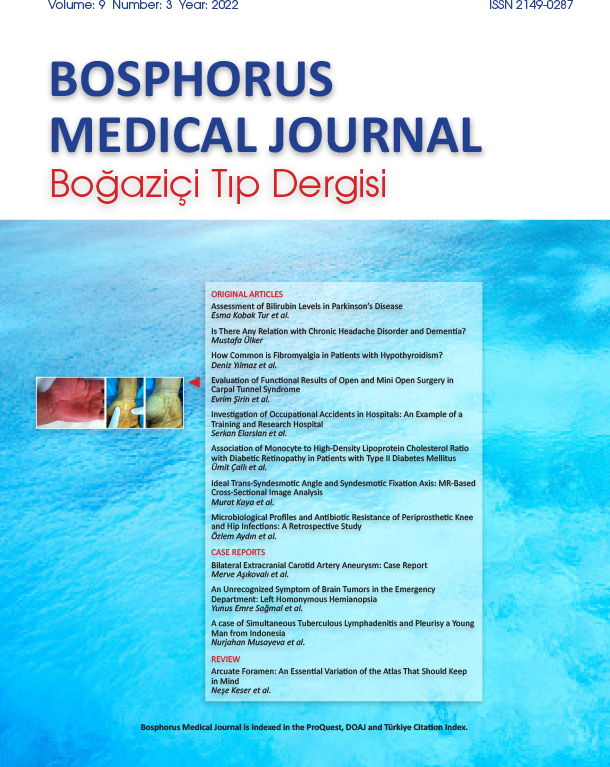Volume: 7 Issue: 1 - 2020
| ORIGINAL RESEARCH | |
| 1. | Cigarette Addiction in Flight Personnel and Coping Methods with Nicotine Deficiency during Flight Gülay İlkhan Daşdemir, Hakan Çelikhisar doi: 10.14744/bmj.2019.79553 Pages 1 - 10 INTRODUCTION: Smoking is an addictive habit used by many people of all ages and occupations. Smoking adversely affects users physically, spiritually, socially and economically. Airline companies implement policies to ban smoking. Flight performance may be reduced in flight personnel, especially in pilots who smoke. Studies on smoking are limited in cabin crew, pilot and other flight crew personnel. Smoking is prohibited during the flight. In this study, we aimed to evaluate the smoking-related habits of active smokers and quitted flight personnel, especially on long flights dealing with what symptoms they experienced most frequently due to nicotine deficiency during the flight and how they tried to cope with this situation. METHODS: In this study, a questionnaire was applied between May and July 2019 to cabin crew, pilot and other flight crews who fly in Turkey and abroad. The surveys were conducted on a voluntary basis after obtaining the written document approvals at Istanbul Airport, Sabiha Gökçen Airport and İzmir Adnan Menderes Airports at the same time. The criterion of quitting was accepted as no smoking for a year, and as a criterion for smoking, at least one smoking per day was accepted. RESULTS: This study was conducted with a total of 263 participants. All of the participants were flight personnel and worked as cabin crew, pilot, dispatcher, technician, loadmaster and so on. Nicotine deficiency during the flight was felt in 18.3% of the participants, while 9.9% often felt nicotine deficiency, 47.5% sometimes felt, and 24.3% did not feel nicotine deficiency. The most common factor aggregating the sense of nicotine deficiency during the flight was rituals, including tea and coffee, with a rate of 36.9%. This was followed by long flight times with a rate of 34.6%. Among study participants, 52.1% cope with nicotine deficiency by eating-drinking snack, 35% by suppressing, 9.1% trying to cope by wearing a nicotine band. The most common desire to eat was followed by restlessness and lack of concentration, respectively. DISCUSSION AND CONCLUSION: Cigarette addiction is an important problem in flight personnel and may force employees psychologically and diminish their productivity. This research we conducted in this special group aimed to examine the methods of coping with tobacco addiction, and there is a need for research to develop successful tobacco control and quitting methods for similar specific groups. |
| 2. | Analysis of Pediatric Traumas: Characteristics and the Role of Scoring Systems Hasan Aldinç, Cem Gün doi: 10.14744/bmj.2019.32932 Pages 11 - 15 INTRODUCTION: Trauma is a major health problem in the pediatric age group. Various etiological factors can be accounted for the traumas, and they cause significant mortality and morbidity in children. Multiple scoring systems have been developed for evaluating trauma patients. The present study aims to investigate to find out which trauma scoring system used in pediatric trauma is superior to others. METHODS: This retrospective study was conducted in the Emergency Department of a private university hospital that accepts over 200.000 patients annually. Records of all 20314 trauma cases between 0 and 18 years of age, who were referred to ED of a private university hospital in two years, were searched, and 251 of them who were hospitalized evaluated retrospectively. Demographical, etiological, and clinical characteristics, including scores of five trauma scoring systems, were analyzed. RESULTS: The mean age of the cases was 6.8±5.4 years, 86.9% of the cases had blunt trauma, and 46.9% had isolated head trauma. The most frequent trauma type was falling from a height (57.3%), followed by traffic accidents (25.8%). Mean pediatric trauma score of the patients was 9.41±1.32, mean Glasgow Coma Score was 14.79±0.88, mean Injury Severity Score was 7.74±8.44, mean Revised Trauma Score was 7.84±0, mean Trauma Revised Injury Severity Score blunt was 98.45±7.71 and mean Trauma Revised Injury Severity Score penetrating was 98.61±6.90. The mean duration of the Intensive Care Unit and ward stay was 2.6±3.1 and 1.9±2 days, respectively, and the total duration of hospitalization was 2.2±2.7 days. DISCUSSION AND CONCLUSION: The trauma scores provide predictive value for clinical severity and treatment in the initial evaluation of cases at admission to the Emergency Department. In this study, we found that Injury Severity Score and Trauma Revised Injury Severity Score are more valuable than the other scoring systems for determining the patient's length of stay in the hospital. |
| 3. | Microalbuminuria in Patients with Acute Ischemic Stroke Deniz Çelebi Sicimoğlu, Eren Gözke, Pelin Doğan Ak doi: 10.14744/bmj.2019.44127 Pages 16 - 20 INTRODUCTION: This study aims to investigate the presence of microalbuminuria (MAU) as a risk factor in patients with acute ischemic stroke (AIS). METHODS: Thirty patients (19 female and 11 male; mean age 69.4±11.9 years) hospitalized with the diagnosis of acute ischemic stroke were enrolled in this study. Microalbuminuria was assessed from the urine samples of patients obtained within 24 hours after the onset of ischemic stroke. Microalbuminuria was accepted as normal if the level was less than 30 mg/day and as high if the level was between 30-300 mg/day. Data obtained were compared with the data of the controls (16 female, 14 male; meanage 64.9±14.2). RESULTS: A significant difference was not detected between the patients and the control groups for gender and mean ages. When data of the cases with AIS and data of the control group were compared, the mean microalbuminuria level of the AIS group was significantly higher than the control group. Microalbuminuria was present in 23 (76.6%) cases with AIS. Hypertension, diabetes mellitus, recent ischemic stroke, hypercholesterolemia, alcohol and smoking were found in 16 (53.3%), 9 (30.1%), 5 (16.6%), 18 (60.2%), 10 (33.3%), 12 (40.7%) cases with AIS, respectively. The incidence of microalbuminuria in cases with hypertension, diabetes, recent ischemic stroke, and cigarette smoking was significantly higher. Microalbuminuria was found in two (6.3%) cases of the control group. DISCUSSION AND CONCLUSION: Our findings support the hypothesis that microalbuminuria may be a risk factor of ischemic stroke. |
| 4. | Retrospective Evaluation of the Treatment Results of Patients with Chronic Hepatitis B and C Infections Servet Öztürk, Nesrin Turker doi: 10.14744/bmj.2020.41033 Pages 21 - 27 INTRODUCTION: Hepatitis B and hepatitis C infections are the major causes of death due to chronic liver disease. Treatment is very important in reducing long-term cirrhosis and hepatocellular carcinoma. In this study, we aimed to determine the real-life data of patients treated with hepatitis B and C. METHODS: Thirty patients with chronic hepatitis B and 21 patients with chronic hepatitis C who were treated in an Infectious Diseases and Clinical Microbiology outpatient clinic in a training and research hospital in Izmir between May 2007 and December 2008 were retrospectively evaluated in this study. RESULTS: In chronic hepatitis B patients, the virological response rate to 48 weeks of pegylated interferon treatment was 57%. However, in 85% of the patients who developed virological response at the end of the treatment, we started oral antiviral treatments within a year due to biochemical and virological exacerbations. HBeAg seroconversion developed in two of the 14 patients receiving pegylated interferon treatment, while 11 of 14 patients were switched to oral antivirals. Virological and biochemical suppression was achieved in one patient. In patients who received entecavir and tenofovir treatment, virological response rates were 91% and 100% at 48 weeks of treatment, respectively. The rate of sustained virologic response was 100% in patients treated with ribavirin plus pegylated interferon treatments in 21 hepatitis C patients. DISCUSSION AND CONCLUSION: We think pegylated interferon treatment should be given only to selected chronic hepatitis B patient groups with HBeAg (+), low viral load and high ALT levels because of the low treatment response to a high potential for side effects. Although direct-acting antivirals (DAA) are recommended treatments for patients with Chronic hepatitis C due to their high persistent virological responses and much fewer side effects, especially in developing and undeveloped countries, because of the high cost of DAA drugs, pegylated interferon alfa 2a or 2b treatment combined with ribavirin should be considered as an alternative. |
| CASE REPORT | |
| 5. | A Case Report of the Recurrence of a Rare Cardiac Low-Grade Fibromyxoid Sarcoma and Mortality Emre Özdemir, Mustafa Karaca, Fülya Çakalağaoğlu Ünay doi: 10.14744/bmj.2019.39206 Pages 28 - 31 As the majority of cardiac tumors are benign, malignant tumors may be easily missed. The case presented here was a female with complaints of dyspnea who was diagnosed with a left atrial mass of regular shape. After surgical excision with a pre-diagnosis of hemangioendothelioma in the frozen-section, the operation finished with mitral valve replacement. The pathological diagnosis from the immunohistochemical examination was of low-grade fibromyxoid-sarcoma. At three months postoperatively, the patient was re-hospitalized with dyspnea. Echocardiography detected a giant mass in the left atrium, 45 x 24 mm in size. The hemodynamic collapse resulted in mortality. The idea that cardiac tumors are more frequently benign causes malignant masses to be overlooked. With the perspective of an internal medicine specialist, the characteristics of each cardiac tumor should be evaluated with both clinical and imaging methods before the cardiac surgery. |
| 6. | Probability of Colon Cancer Recurrence in Parastomal Hernia Repair and Resection for Prolapse: A Rare Case Report Orhan Aras doi: 10.14744/bmj.2020.73745 Pages 32 - 33 Recurrences after abdomnoperianal resection for rectal cancer are most commonly seen in the pelvis. In this patient group, the possibility of developing a parastomal hernia is high. In the repair of parastomal hernia, sometimes resection is needed and the removed colon segment is examined by the pathologist. We want to share a rare case of recurrent parastomal hernia in the literature. |
| 7. | Successful Treatment of Paradoxical Psoriasis with IL 17 Inhibition: Case Reports Gamze Gül Güleç, İlknur Aktaş, Feyza Ünlü Özkan, Nurdan Yurt, Eylem Emel Arıkan doi: 10.14744/bmj.2020.74755 Pages 34 - 37 Paradoxical psoriasis (PPs) is new-onset psoriatic skin lesions or worsening of the existing psoriatic skin lesions during anti-TNF therapy. PPs occurs in 2-5% of patients using anti TNF drugs (1). It is a class effect of anti-TNF agents rather than a drug effect and has been observed with all diseases for which TNF-a inhibitors are indicated (2). The time between the starting treatment and the appearance of lesions can range from a few days to years. Discontinuation of anti-TNF therapy, replacement of biological agents, or continued adjuvant therapy are among the treatment options. Inhibition of IL17 can lead to a decrease in PPs and rheumatic disease activity. We aimed to discuss the treatment process and secukinumab in three cases in PPs and to discuss the remission with IL-17 inhibition. |




















